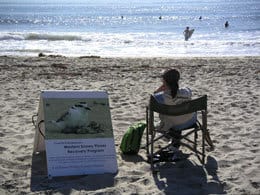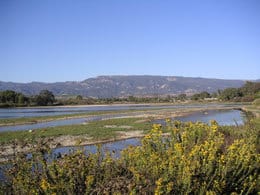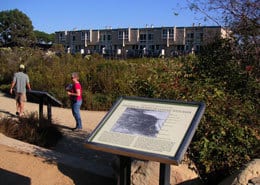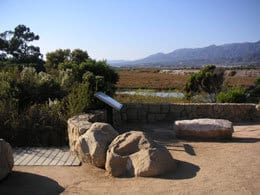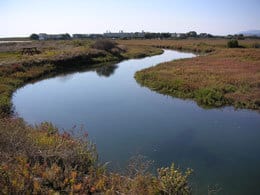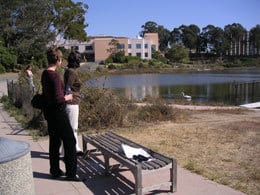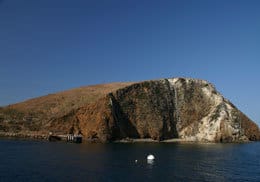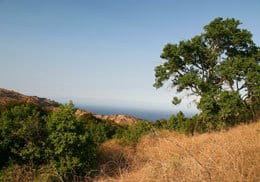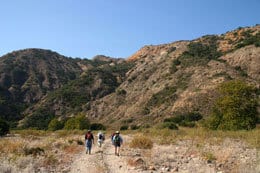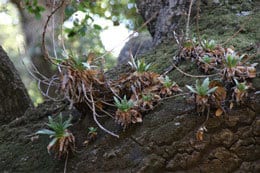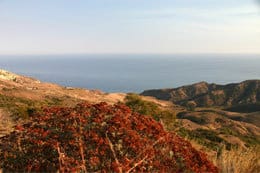UCSBThe 13th annual SERCAL conference, (Oct. 26-29th 2006) was held on the beautiful campus of UC Santa Barbara in the University Center. Bordering the landmark restored lagoon, (a living example of the goals discussed in the conference rooms that weekend), the conference boasted in impressive array of presenters and fascinating local fieldtrips. The fieldtrips gave participants a chance to see examples of projects that were actively employing the very concepts discussed in the technical sessions. Representatives from TOLN had the special opportunity to participate in the field sessions and visited many beautiful sites in and near Santa Barbara. It was encouraging to see so many successful projects making positive environmental impacts even with the constant challenges they faced. Coal Oil Point Reserve (COPR)Located on 158 acres of UCSB’s West Campus and named for the numerous oil seeps near its coast, COPR is one of the best remaining examples of a coastal-strand environment in Southern California. Dr. Cristina Sandoval, the director of the reserve, generously shared her experiences in public outreach, bird species renewal, plant community restoration, and invasive species eradication on the sand dune, sandy beach and adjacent estuary mouth habitat. Protection of a specific area of sandy beach has resulted in a dramatic increase in the number of both wintering and breeding Western Snowy Plovers, a federally listed threatened species on the Pacific Coast. (for more information on sharing the beach with Plovers: http://www.parks.ca.gov/?page_id=22262) Carpinteria Salt Marsh Reserve (CSM)Located 20 miles East of UCSB, CSM covers 120 acres of 230 acres of wetland and upland habitat associated with the estuary historically known as El Estero. This is one of the few remaining coastal estuaries in California, providing significant coastal wetland habitat to hundreds of species of plants and animals. An on-site interpretive center, teaching amphitheater and nature trail has been developed at the nearby CSM Nature Park. In partnership with the city, the Land Trust for Santa Barbara County, and many other individuals and entities, and inspired by the vision of Dr. Wayne Ferrin of UCSB, a complete working ecosystem has been restored with the objective of enhancing public outreach. It is an example for every city to preserve and restore its best wild places and find creative ways to share the beauty with the public. http://www.sblandtrust.org/carpmarsh.html UCSB Campus RestorationUCSB is home to the Cheadle Center for Biodiversity and Ecological Restoration, whose staff manages and restores campus natural areas and mitigation projects. Such projects include the expansive undertaking of restoring the Campus Lagoon as well as six acres of the Manzanita Village Restoration Project. The original goals of the projects were to enhance and restore the disturbed habitat in and around the campus. In time, they found that through signage and programs they could include the residents and student body, recognizing the importance of the human as an important part of this delicate ‘ecosystem’. Incorporating restoration in and among student life through education, participation, and well-maintained trails became increasingly valuable. As stakeholders, the residents learn about the new habitat and learn to love it. Santa Cruz Island (SCI)This exhilarating and exclusive tour of the largest and most topographically diverse of Southern California’s offshore islands was an incredible treat. This island is very active area with research projects underway through the University of California, National Park Service & the US Geological Survey with overview of shared management by NPS, The Nature Conservancy and UC. Santa Cruz, like the other Channel Islands, is home to many endemic plants and animals. We had a first hand look at how these threatened species are rebounding following the recent removal of feral pigs and the earlier cessation of grazing activities. Restoration efforts over the past 25 years have been complex and controversial at times, as both historical preservation and native species recovery were priorities. The large scale and long-term progress of this project was impressive and encouraging. Learn more here and here Many thanks to SERCAL for inviting Tree of Life Nursery to participate in this years conference and to all of the excellent presenters, knowledgeable field guides and especially to the coordinators of the conference. It is inspiring to see the positive impacts of successful restoration projects, despite and through the failures and setbacks, (both biological and political), that accompany such large undertakings. Also learning through the presenters about the tools that contribute to the success of such projects made this conference a valuable experience for all who attended. Featured Photo Credit: Laura Camp, Tree of Life Nursery © 2006. UCSB Lagoon |
|
Case Study: SERCAL 2006
- Posted in: About Tree of Life, California Native Plants
- Tags Conservation, Ecosystems
